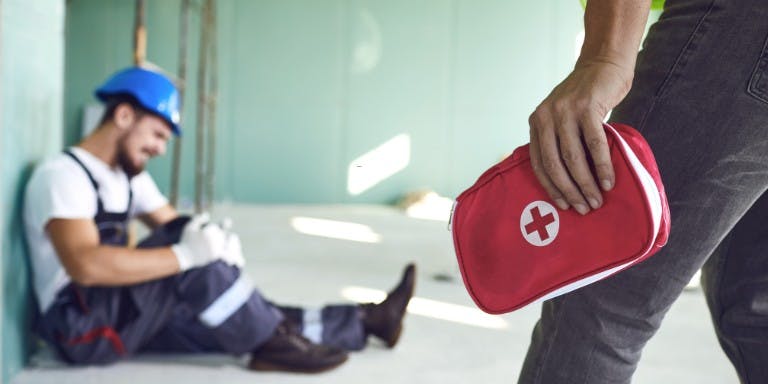First published on Thursday, June 4, 2020
Last updated on Friday, September 12, 2025
Jump to section
- What is first aid?
- Basic first aid techniques that you should know
- What are the legal requirements for first aid in the UK?
- Types of first aid courses
- Assessing your workplace first aid needs
- Tailoring first aid to industry-specific risks
- First aid for remote workers
- Appointing and training First Aiders
- Workplace first aid kit requirements and facilities
- Should you have a first aid policy?
- The importance of record keeping and reporting first aid incidents
- How health & safety software simplifies first aid management
Ensuring a safe working environment isn’t just a legal obligation; it’s a demonstration of care for your workforce. Adequate first aid measures are critical to your health and safety strategy.
In fact, according to the Health and Safety Executive (HSE), thousands of workplace injuries occur annually in the UK, and many could be mitigated or better managed with proper first aid procedures.
If you need help immediately, BrightSafe’s 24/7 health and safety advice line is available for expert guidance.
What is first aid?
First aid is the emergency treatment provided to someone injured or unwell before professional medical help arrives. It covers everything from minor treatments like applying a bandage to performing CPR in life-threatening situations.
UK law mandates employers must provide adequate first aid provisions to ensure timely help for employees who need first aid assistance.
The importance of first aid in the workplace
Accidents happen, and a well-implemented first-aid system can significantly reduce the impact of injuries and illnesses. Prompt response saves lives and ensures quicker recovery and less downtime for employees.
By prioritising first aid, you demonstrate to your employees that their safety matters, boosting morale and productivity.
Basic first aid techniques that you should know
Key techniques include:
CPR (Cardiopulmonary Resuscitation): Essential for reviving someone who has stopped breathing.
Bandaging: Treats wounds and prevents infections.
Handling common injuries: Techniques for treating sprains, burns, and fractures.
Other essential techniques to be aware of include:
Choking relief: Knowing how to perform abdominal thrusts or back blows can save lives.
Dealing with allergic reactions: Administer antihistamines or use an EpiPen if necessary.
Seizure response: Knowing how to protect a person experiencing a seizure and ensuring they are safe until help arrives.
These basic skills can make a significant difference in an emergency, helping ensure the safety of your team.
What are the legal requirements for first aid in the UK?
Employers must provide adequate first aid in the UK under the Health and Safety (First Aid) Regulations 1981. These regulations apply to all workplaces, regardless of size.
The level of first aid provision depends on a risk assessment that accounts for workplace hazards, size, and accident history.
What the law requires from employers
As an employer in the UK, you must:
Conduct a first aid needs assessment, ensuring it considers workplace-specific risks
Provide sufficient first aid equipment and facilities
Ensure that trained first aiders are available, especially in higher-risk environments
For example, an office with minimal risks may only need a basic first aid kit and a trained first aider. At the same time, a construction site may require more extensive provisions, such as additional kits or even dedicated first aid rooms.
Types of first aid courses
Different workplaces require different levels of first aid training. Here are some of the most common courses available in the UK:
Emergency first aid at work (EFAW): This introductory course covers essential first aid skills for low-risk environments like offices.
First aid at work (FAW): A more comprehensive course suitable for higher-risk workplaces like construction sites, factories, or warehouses.
Specialised first aid training: Specialised training may be required for environments with specific risks, such as outdoor work or dealing with hazardous materials.
Mental health first aid: This course trains first aiders to recognise and support mental health issues in the workplace, which is becoming increasingly common in larger organisations.
Assessing your workplace first aid needs
Conducting a thorough first aid needs assessment is the first step in ensuring compliance and employee safety. Consider the following:
Size of the workforce: Larger teams may require multiple first aid kits and trained first aiders.
Types of hazards: Identify risks specific to your industry.
Accident history: Review past incidents to determine recurring risks.
Specific employee needs: Consider lone workers or remote locations.
The HSE advises that these assessments should be regularly reviewed, especially when new hazards or changes to the workplace are introduced.
Tailoring first aid to industry-specific risks
Different industries present unique hazards that require specialised first aid provisions. For example:
Offices: Generally low-risk, where basic first aid kits and EFAW-trained staff suffice.
Construction sites: High-risk, where FAW-trained first aiders and more comprehensive kits, including trauma supplies, are necessary.
Retail and hospitality: These environments may require first aiders to be prepared for slips, falls, burns, or allergic reactions.
Remote or lone workers: Workers in isolated areas may require portable first aid kits and communication tools to ensure help can reach them quickly.
First aid for remote workers
Ensuring first aid provisions for remote or lone workers can be particularly challenging. Best practices for equipping these employees include:
Portable first aid kits specifically tailored to the environment.
Communication tools like mobile phones or radios to call for help quickly.
Training on self-administering basic first aid in case they are injured and alone.
To learn more about your responsibilities for the health and safety of remote workers, see Health & Safety for your employees working from home.
Appointing and training First Aiders
Choosing the right first aiders is a crucial component of workplace safety.
Role of a First Aider
First aiders are responsible for providing immediate care, maintaining first aid equipment, and contacting emergency services when necessary.
Criteria for selecting First Aiders
Select individuals who:
Are available during working hours.
Are willing to take on the responsibility.
Work near high-risk areas.
Workplace first aid kit requirements and facilities
Having the right equipment is just as crucial as having trained personnel. Your first aid kit should include essentials like:
Plasters and bandages
Sterile wound dressings
Disposable gloves
Eyewash and cleaning wipes
You also need to make sure that the kits are easily accessible, clearly marked, and regularly restocked.
In high-risk environments, consider providing Automated External Defibrillators (AEDs), which can be lifesaving in cases of cardiac arrest. The HSE highlights that more significant, hazardous workplaces may require designated first aid rooms to handle more severe injuries.
Should you have a first aid policy?
Absolutely! A comprehensive first aid policy ensures consistency and preparedness in emergencies. Your policy should cover:
Procedures for reporting accidents
Responsibilities of first aiders
Locations of first aid kits and facilities
Informing employees
It’s important to remember that all employees must be regularly informed and trained on these protocols to act swiftly in an emergency.
Reviewing and updating the policy
To ensure that your policy is always up to date, you should review and update your policy regularly to keep it relevant, especially if your workplace changes or new risks are identified.
Did you know that our BrightSafe Health & Safety Software has an online HR document library that includes templates for first aid policies and checklists to make this process easier?
The importance of record keeping and reporting first aid incidents
Accurate documentation is crucial for both legal compliance and improving workplace safety.
Legal obligations under RIDDOR
You must legally report workplace injuries, diseases, and dangerous occurrences under the Reporting of Injuries, Diseases and Dangerous Occurrences Regulations (RIDDOR). This reporting helps identify trends and prevent future incidents.
Best practices for maintaining records
Keep detailed records of all first aid incidents, including the nature of the injury, the treatment provided, and any follow-up actions. Use these records to review and improve your safety measures.
The HSE also recommends using these records to inform ongoing risk assessments and safety improvements.
How health & safety software simplifies first aid management
Investing in health and safety software can make managing first aid provisions easier and more efficient.
Conducting needs assessments
Health and safety software can help conduct thorough needs assessments to ensure the right provisions are in place and tailored to your workplace’s risks.
Tracking training and compliance
Health and safety software will help you track first aid training and certifications, ensuring that all first aiders are updated with their qualifications.
Real-time reporting and analysis
Automated reporting tools provide real-time insights into first aid incidents, helping you continuously improve safety measures. Tools like BrightSafe's accident and near-miss reporting allows you to document incidents in real-time, improving safety and compliance.
First aid isn’t just about ticking a legal box—it’s about showing your employees that their safety matters. You can ensure your workplace is compliant, prepared, and safe by conducting thorough assessments, providing proper training, and using health and safety software.
Explore how BrightHR’s health and safety software can streamline your first aid management and ensure compliance with UK regulations. Book a demo today and make your workplace safer for everyone.
Have a question?
Ask away, we’ve got lightning fast answers for UK business owners and employers powered by qualified experts.

